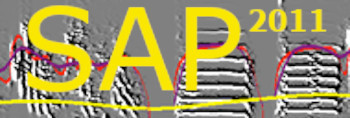Welcome to the Sound Analysis Pro 2011 site 2019
Sound Analysis Pro is a free, open code software for analysis of animal communication
Latest Updates
- New: Sound Analysis Tools for Matlab
- Download Sound Analysis Pro 2011
- Sound Analysis Pro User Manual
- Recently published studies that use Sound Analysis Pro
Sound Analysis Pro 2011 Overview
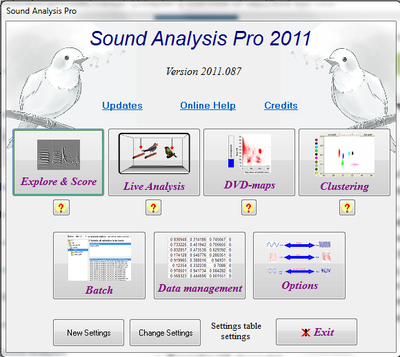
Sound Analysis Pro 2011 performs automated recording and analysis of animal vocalization. It can record, analyze and manage sound data over prolonged periods. It can be used to train animals with playbacks while recording their vocalization, e.g., throughout the vocal development of a bird. The basic analysis include automatic segmentation to vocal sounds to syllables, and calculation (in nearly real time) of acoustic feature (e.g., amplitude, pitch, frequency modulation and entropy). The features are used to summarize the spectral structure of vocal sounds. Advanced analysis includes a variety of similarity measurements, cluster analysis (to identify syllable types), and several methods for displaying distributions of vocal sounds over long time scales (.e.g, scatter plots of an entire song development). SAP2011 can be installed in any Windows 7, 2000 or XP computers. Other operating systems are not supported. For specific hardware requirements (depend on what you want to do) see Chapter 2: Install SAP2011. SAP2011 includes six modules: Recorder, Live Analysis, Explore & Score, Batch, Clustering, and DVD maps.
Recorder (10 channels):
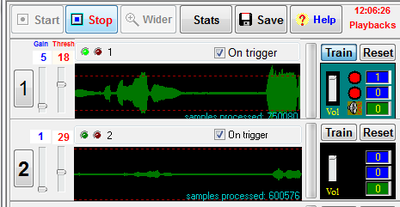
The recorder performs multi-channel (up to 10) recording using most standard and ASIO sound cards. Recording modes include i) Triggered recording: records vocalization that passes an amplitude threshold, including pre-buffering and duration control. ii) Continuous recording: records continuously into files of fixed duration, and iii) Master-slave recording: for synchronized recordings across channels. The recorder allows training with sound playbacks, e.g., by the animal pressing on a lever, etc). It includes an accurate time code, and it can transfer data to the Live Analysis module, which perform spectral analysis and save sounds in daily folders. For more information see Chapter 7: Recording Vocal Sounds
Live Analysis
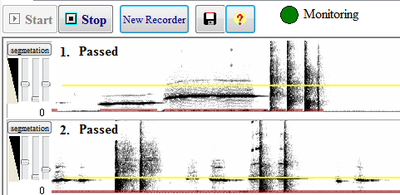
Live Analysis is the companion module of the Recorder. It processes sound data that passed the recorder thresholds and performs spectral analysis and calculation of acoustic features, followed by segmentation to syllable units. The sonogram displayed in nearly real-time to allow simple sound detection settings. In addition to saving sounds, it can also save tables with syllable features, and raw tables of continuous features. Files are automatically arranged in data folders of appropriate capacity, .e.g., of daily folders. For more information see Chapter 8: Live Sound Analysis
Explore & Score
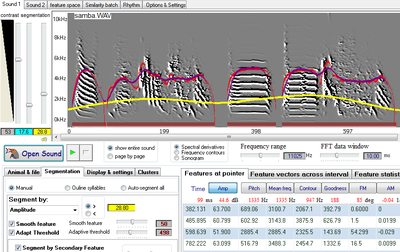
Explore & Score is used to browse sound, examine their features, segment them (manually or automatically), and to perform a variety of measurements that can be easily stored and exported to Matlab or to Excel. It provides variety of graphical representations to examine distribution of features. It is used to score the similarity between sounds, with several alternative methods for scoring similarity. See Chapter 3: Spectral Analysis , Chapter 4: The Song Features , Chapter 5: Exploring Vocal Sounds and Chapter 10: Similarity Measurements.
Batch

The features batch can analyze large amount to sound data to calculate acoustic features and save them into syllable tables and into raw features tables. The tables can include millions of records that can be presented graphically in the DVD module. Thesimilarity batch can be used to perform a large set of similarity measurements. It supports two batch modes: one is for comparing ordered pairs of sounds, and the other is for comparing matrixes (M x N) of sounds. For more information see Chapter 9: Batch & Automation
Dynamic Vocal Development maps
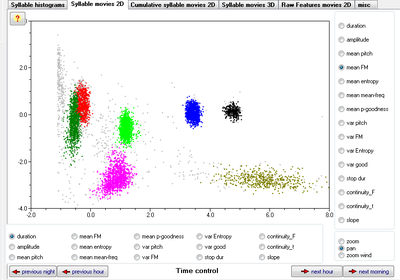
SAP2011 automatically generates and updates a syllable-table for each bird, which summarizes every song syllables produced during vocal development (in a zebra finch, it is typically 1-2 million syllables). Obviously there is a lot of information in those syllable tables. To make this information easily accessible we developed a descriptive model called the Dynamic Vocal Development (DVD) map. DVD maps are presented as movie clips showing how syllable features change during song learning (or as a result of experimental manipulation). In the adult bird, the distribution of syllable structure is highly clustered, and the DVD maps show how these clusters (syllable types) come about. We developed several types of such maps to show different aspects of song development including syntax, circadian factors, and cross time-scales vocal changes. The different modes of DVD maps use shape, color and even sound-clicks to represent different aspects of song structure. Importantly, DVD maps can be played in nearly real-time, so that you can see a vocal change as it occurs. For more information see Chapter 11: Dynamic Vocal Development (DVD) Map
Clustering syllables
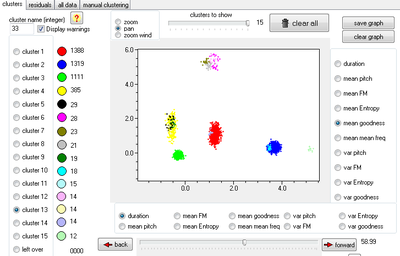
Clustering is used to detect syllable types and to automatically trace vocal changes during song development.We implemented anearest-neighbor hierarchal clustering method into an extensive graphic user interface including a display of clusters in color code, assessment of residuals, and an account of the number of members in each syllable type. The procedure performs the cluster analysis recursively, throughout song development. It provides online visual assessment of the outcome in each stage of analysis. The results of the clustering are automatically registered into the syllable table, so that as you do the cluster analysis you can play DVD maps, and ensure, by inspecting the color-code of each cluster, that the tracing procedure is indeed 'locked on the target'. The tracing of each syllable type progresses from the mature song and back until the clustering procedure fails to trace the syllable type. As long as a cluster can be traced, it is easy to detect vocal changes that occur as the feature of a cluster approaches the final (target) state. Cluster Analysis is therefore a formal way of analyzing (and parameterizing) the DVD map. For more information see Chapter 12: Clustering Syllables.
Online Help
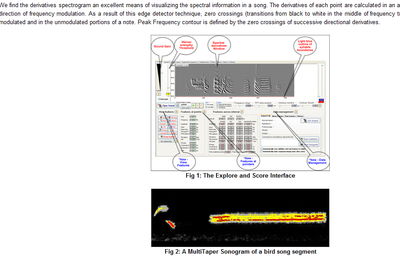
SAP2011 now includes many functions and to make them easily accessible to the user we developed a web help system, that allows quick update and posting of comments. Clicking on the help links in SAP2011 will take you directly to the help pages you need to look at in this site. See User Manual.
